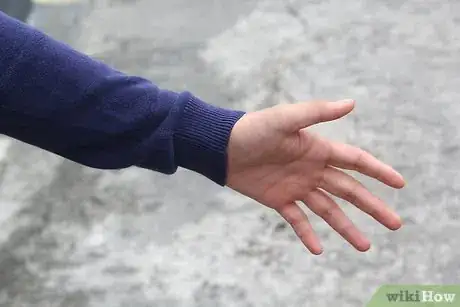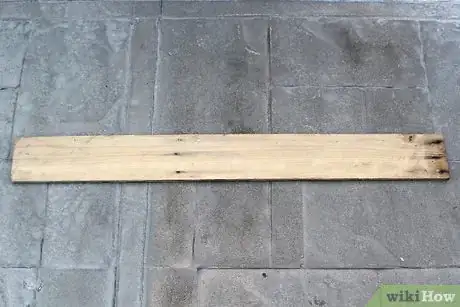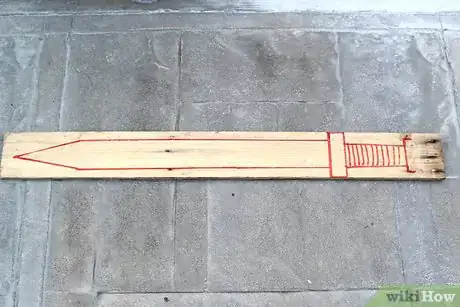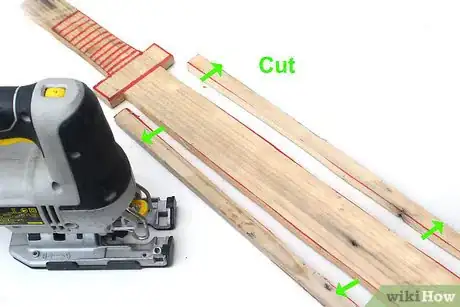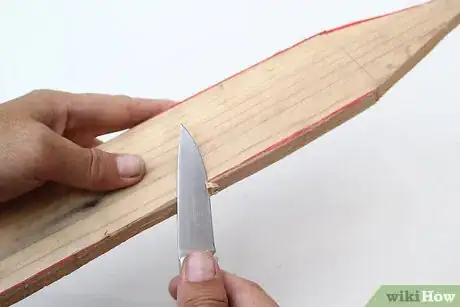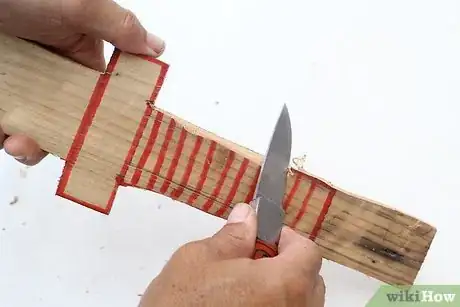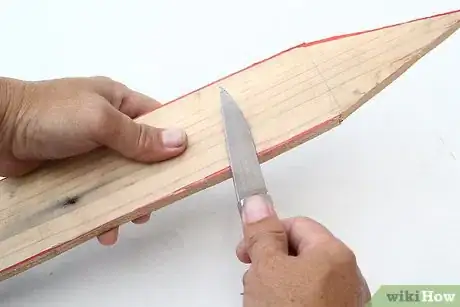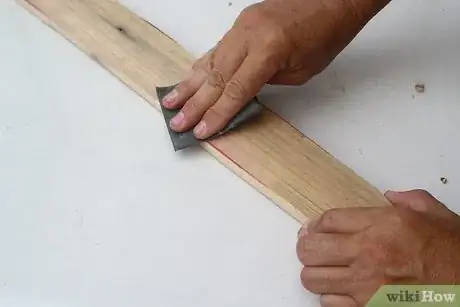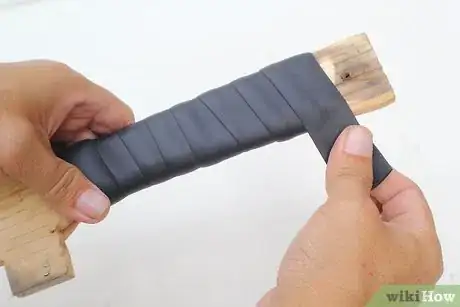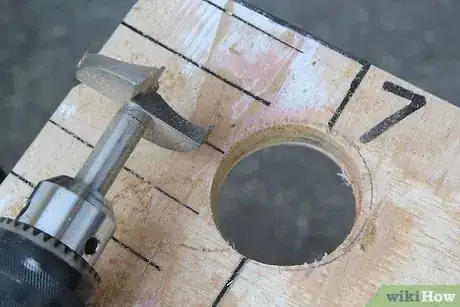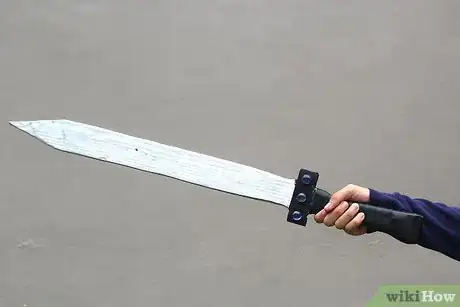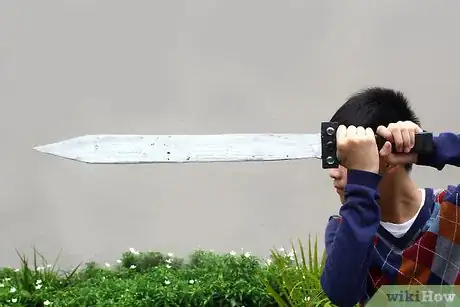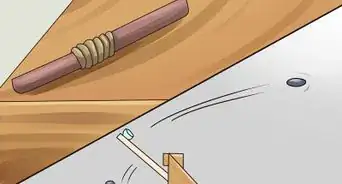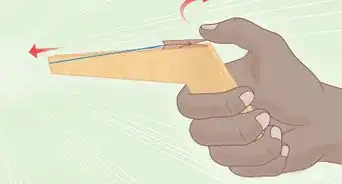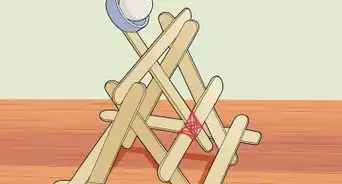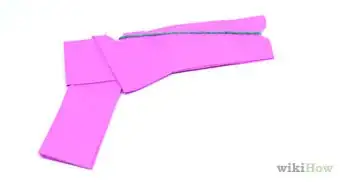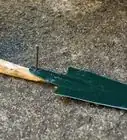This article was co-authored by wikiHow Staff. Our trained team of editors and researchers validate articles for accuracy and comprehensiveness. wikiHow's Content Management Team carefully monitors the work from our editorial staff to ensure that each article is backed by trusted research and meets our high quality standards.
There are 7 references cited in this article, which can be found at the bottom of the page.
This article has been viewed 470,877 times.
Learn more...
If buying a sword is outside your budget, or if you want a self-made sword for a costume or practice, you can make your own out of wood. A 2x4 of suitable length will be widely available and work well for this project. Size your sword so it fits your body. Fashion your sword out of your piece of wood. Finish the sword so its rough edges are sanded away and the final outcome is polished and professional looking.
Steps
Figuring Out Your Ideal Sword Length
-
1Assume a straight-backed posture. Keep your spine straight and your shoulders back. Your arms should hang loosely at your sides. Your hands and fingers should also be loose and pointing down at the floor.
-
2Identify your dominant hand. The term "dominant hand" refers to the hand you are most comfortable with for precision tasks. This generally equates to the hand you use to write, handle tools, or throw a ball.[1]
- In some cases, your sword hand may not be the same as the hand you use for writing or using tools.
- To verify your sword hand, hold a straight piece of wood or a household item. This should be roughly the length of your forearm. The hand in which this is most comfortable is your sword hand.
Advertisement -
3Measure between the cleft of your thumb/forefinger and eye. When you spread your fingers out, the space between your thumb and forefinger will form a V-shape. With your hand still loose at your side and your fingers pointing toward the ground, use a tape measure to determine the distance between the same side eye as your dominant hand and the base of this V-shape in your dominant hand.
- This measurement can be difficult to take accurately without help. You may want a friend or family member to assist you in this.
-
4Round up or down to the next full inch (2.5 cm). Generally, when you are within a ½ in (1.2 cm) of the next full inch mark, round up to the next inch. When you are over a ½ in from the next full inch, round down to the next full inch mark.
- Depending on the kind of sword you are using, sizing conventions can vary. These measurements are for a modern, straight bladed military saber.
- Most mass produced bladed weapons, like swords, are broken down into sizes. These sizes are generally in standardized increments, like 1 or 2 inches (2.5 to 5 cm).
- As an example of a sword with a different size expectation, a traditional broadsword ranges from 30 to 45 inches (76.2 to 114.3 cm).[2]
Fashioning the Sword
-
1Choose wood slightly longer than your ideal length. Use a piece of wood that's slightly larger than your ideal size. This will allow you to some room for error when you use a knife to shave away excess wood with a knife to shape your sword.
- To check your wood for rottenness, strike it against a hard surface. If it breaks or cracks, select another piece of wood.[3]
-
2Outline your sword shape on 2x4 planks. Use a pencil to draw the approximate shape of your sword on the 2x4. This shape can be curved, like a traditional katana or scimitar, or straight edged on both sides with an angled or triangular point.
- When drawing your outline, remember the cross guard of the sword. This is located at the base of the blade, between the blade and handle of the sword.[4]
- The tip of swords are generally angled or pointed. Be sure to include this in your outline. A 45° angle from the tip to one side of the sword will provide a suitable angled point.
-
3Cut the sword to your ideal length. Measure the ideal length of your sword on your wood and mark it with a pencil. Use a hand saw to cut free excess length from the wood. Remember to cut along the angle or point you've drawn on the wood for the point.[5]
-
4Shave away excess wood to form the blade. A sharp woodworking knife will work best for this, but any sharp, sturdy knife can be used. Carve away wood to create the blade of your sword.[6]
- For one-sided blades, the blade should narrow on its "sharp" side, creating a triangular shape. The wood should thicken toward the opposite, non-bladed side.
- For double sided swords, the shape of the blade will be roughly that of a diamond. The thickest part of this blade will be at the center of the blade, with both "edged" sides thin.
-
5Fashion the handle and cross guard. A somewhat elliptical (oval) shape will work best for your handle, which should be thinner than the blade. The cross guard should also be thin and form the crossing part of a t-shape between the blade and handle.[7]
- An oval shape will be more comfortable to hold onto when using your sword than a purely circular one.[8]
- To make a distinct cross guard, a file will work best. Use your knife to form the general outline at this point. Later, you'll use sandpaper to smooth it, and a file to make it distinct.
-
6Adjust the weight of your sword as necessary. Hold your sword in your hand. If it feels heavy, continue using your knife to shave away wood from the thickness of the blade and handle.
- Some wood is heavier than others. Heavier woods may require very thin blades and handles for them to be of comfortable weight.
- Making the blade and handle of your sword too thin can compromise your sword's sturdiness.
Finishing the Sword
-
1Sand your sword blade, handle, and cross guard. Use medium grit sandpaper (60 to 100 rating) to take off rough, irregular edges and burrs from the wood. Use firm pressure and to rub the wood with the sandpaper.
- Be patient with this process. Sanding can take a while, but a well sanded sword will look more professional made.
- To speed up this process, you could clamp your sword to a work bench and use a hand sander.[9]
-
2Wrap the handle of your sword. This will not only make your sword look stylish, but will also provide you a better grip on the handle when using your sword. Wind electrical tape around the handle of your sword to make a grip.[10]
- Sweat from your hand along with the force of hitting something with your sword can jostle it from your grasp if you don't have a grip.
- Alternatively, you can use duct tape for the grip of your sword. Different patterns/colors of tape can be used to suit your preference.
-
3File your cross guard to make it distinct. A file will allow you to make more precise, deeper notches in the top of the handle and bottom of the blade. Take your file and remove wood directly above and below the cross guard.
- Using a file in this fashion will better separate your cross guard from the handle and blade the sword.
-
4Add a separate cross guard piece, alternatively. Cut a piece of wood, plastic, or metal in a circular shape that is roughly 2 in (5 cm) thicker than your sword handle. Cut a hole directly in the center of this that is just barely larger than your sword handle.
- Slide the separate cross guard piece up the handle. The guard should catch where the blade thickens and go no farther.
- To hold your cross guard in place, wrap twine or string around the guard. Alternate between the top and bottom of the guard so the string winds along the base of the blade and top of the handle. Tie the string off in a simple knot.
-
5Add accents to suit your preference and enjoy. Tie tassels to the base of the handle of your sword.[11] Use a marker to draw designs on the blade. Etch designs in your sword with a knife.[12]
- To make a sheath, cut one long sleeve off of an old shirt. sew one end of a long sleeve closed. Slide your sword inside, and you're done.
-
6Finished.
Community Q&A
-
QuestionCan I make a broadsword with wood?
 Community AnswerDefinitely. Yjust need to make sure that the wood is wide enough to be considered a broadsword. Also, consider using poplar wood or oak, as these are stronger than pine.
Community AnswerDefinitely. Yjust need to make sure that the wood is wide enough to be considered a broadsword. Also, consider using poplar wood or oak, as these are stronger than pine. -
QuestionHow do you know if it is the right wood type?
 Community AnswerIf you plan to use your sword for practical reasons, the wood needs to be very hard like oak, beech, or something similar. However, if your sword is just going to be ornamental, any wood will do.
Community AnswerIf you plan to use your sword for practical reasons, the wood needs to be very hard like oak, beech, or something similar. However, if your sword is just going to be ornamental, any wood will do. -
QuestionHow long does the wood have to be?
 Community AnswerIt should be a bit longer than you want the sword to be, so that you can sand off rough edges and get the best length. Start with it a bit longer than you want it to be, and shorten it a little at a time until it feels right.
Community AnswerIt should be a bit longer than you want the sword to be, so that you can sand off rough edges and get the best length. Start with it a bit longer than you want it to be, and shorten it a little at a time until it feels right.
Warnings
- Immediately stop using your sword if it cracks. Once the sword cracks, it has a high potential to shatter. Wood fragments can cause permanent damage to your eyes and can even lodge in your skin, causing serious harm.⧼thumbs_response⧽
- Hand tools, if used improperly, can be dangerous. Use caution when using a knife, saw, and other tools.⧼thumbs_response⧽
- Your sword will most likely crack or break (this is very common) if used in serious practice or combat.⧼thumbs_response⧽
- Use caution when practicing with your sword. Even though it is wooden, it can still cause a serious injury.⧼thumbs_response⧽
Things You'll Need
- Duct tape
- Electric tape (optional)
- Handsaw (optional)
- Knife
- Liquid tape(optional)
- Pencil
- Sandpaper (recommended)
- Tape measure
- Wood (like a 2x4)
References
- ↑ https://www.scientificamerican.com/article/what-causes-some-people-t/
- ↑ http://www.medieval-life-and-times.info/medieval-swords-and-armor/broadsword.htm
- ↑ http://ejmas.com/tin/tinart_taylor_1100.htm
- ↑ https://myarmoury.com/feature_anatomy.html
- ↑ https://www.youtube.com/watch?v=JfGn-GrYtG4
- ↑ http://ejmas.com/tin/tinart_taylor_1100.htm
- ↑ https://www.youtube.com/watch?v=JfGn-GrYtG4
- ↑ https://myarmoury.com/feature_hilts.html
- ↑ https://www.youtube.com/watch?v=JfGn-GrYtG4
About This Article
To make a wooden sword, measure from the cleft between your thumb and forefinger up to your eye, then round that measurement to the nearest full inch to determine your ideal sword length. Next, choose a piece of sturdy wood slightly longer than your ideal length and draw the outline of your sword on the surface. Use a hand saw to cut the wood down to your ideal length, then carve the excess wood around the outline. Finish up by smoothing away any rough edges with medium-grit sandpaper! For tips on creating a distinct cross guard for your sword, read on!

